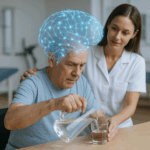Overview of Conditions
Cervical radiculopathy refers to the compression or irritation of one or more nerve roots in the cervical spine, resulting in radiating pain, weakness, numbness, or tingling in the upper extremities. This condition is often caused by herniated discs, cervical spondylosis, or foraminal stenosis, leading to nerve root compression.
The acute onset of cervical radiculopathy can result in severe pain, muscle weakness, and impaired function, which may significantly impact the quality of life and daily activities. It commonly affects individuals between the ages of 40 and 60 years, though it can occur in younger adults due to traumatic injury or disc herniation.
Common Symptoms:
- Sharp, shooting pain radiating down the arm (dermatomal pattern).
- Numbness or tingling in the arm, hand, or fingers.
- Muscle weakness, particularly in the shoulder, elbow, or hand muscles.
- Decreased reflexes in the affected arm.
Assessment and Evaluation
A comprehensive assessment is essential to determine the severity of the condition, identify potential causes, and guide the treatment approach. The following steps should be followed:
1. Subjective Assessment:
- Pain history (onset, intensity, and location of pain).
- Aggravating factors (e.g., neck movement, lifting, sneezing).
- Alleviating factors (e.g., rest, positioning).
- Duration and frequency of symptoms (acute vs. chronic).
- Impact on functional activities (e.g., difficulty lifting, reaching, or driving).
2. Objective Assessment:
- Postural assessment: Look for abnormal postures such as forward head posture or scapular winging.
- Range of motion (ROM): Measure cervical spine flexion, extension, rotation, and lateral bending.
- Neurological examination:
- Sensory testing: Assess dermatomal patterns for sensory loss.
- Strength testing: Perform manual muscle testing (MMT) for affected muscle groups (e.g., deltoid, biceps, triceps).
- Reflex testing: Check deep tendon reflexes (e.g., biceps, triceps, brachioradialis) to identify any neurological deficits.
- Spurling’s Test: To reproduce radicular pain and confirm nerve root involvement.
- Neck Disability Index (NDI) or Visual Analog Scale (VAS): To quantify the severity of pain and functional limitations.
3. Imaging:
- If clinical suspicion is high, MRI scans may be recommended to confirm disc herniation or narrowing of the foramina.
- Electromyography (EMG) can be used in cases of persistent symptoms to assess nerve root compression.
Goal Setting
The goals should be tailored to the patient’s condition and the severity of symptoms. Common goals include:
1. Short-Term Goals (1-2 weeks):
- Reduce pain and inflammation in the cervical spine and upper extremity.
- Relieve muscle spasm and tension in the neck and shoulder muscles.
- Improve posture and neck mobility.
- Address any immediate neurological symptoms (e.g., tingling, weakness).
2. Long-Term Goals (4-6 weeks):
- Restore normal range of motion and function of the cervical spine.
- Improve muscle strength, particularly in the neck, shoulder, and upper limb muscles.
- Prevent recurrence of symptoms through postural education and ergonomic interventions.
- Enhance overall functional capacity for activities of daily living (ADLs).
Recommended Treatment
Treatment should be multidisciplinary, focusing on pain relief, muscle relaxation, reducing inflammation, and improving strength and mobility. The modalities selected must address both the pain and the underlying causes of the condition.
Disclaimer and Note:
Choose treatment options wisely and appropriately based on the patient’s condition, availability, and preferences. In instances where multiple options are recommended, any one modality may be chosen based on what is most appropriate for the specific case and available resources, such as in electrotherapy. Below are the suggested modalities for treatment:
Electrotherapy
1. TENS (Transcutaneous Electrical Nerve Stimulation):
- Indication: Pain relief by modulating pain pathways.
- Protocol:
- Frequency: 80-100 Hz (high-frequency for pain relief).
- Pulse duration: 50-150 microseconds.
- Mode: Continuous mode.
- Duration: 20-30 minutes per session.
- Mechanism: TENS stimulates A-beta fibers to inhibit pain transmission via the gate control theory and promotes endogenous opioid release.
- Evidence: A systematic review by Johnson et al. (2020) supports TENS for pain relief in radiculopathy patients.
2. Interferential Therapy (IFT):
- Indication: Deep tissue pain and inflammation, especially for radiating pain.
- Protocol:
- Frequency: 4,000 Hz carrier frequency, 100 Hz beat frequency.
- Duration: 15-20 minutes per session.
- Mechanism: IFT uses two intersecting currents to stimulate deep tissues, reduce inflammation, and provide pain relief.
- Evidence: Studies like Alon et al. (2019) confirm the effectiveness of IFT in alleviating pain and inflammation in radiculopathy cases.
Thermotherapy
1. Moist Hot Packs:
- Indication: Muscle relaxation, pain relief, and improvement of local circulation.
- Protocol:
- Apply for 15-20 minutes over the cervical spine and upper back.
- Ensure proper insulation to prevent burns.
- Mechanism: Heat therapy promotes vasodilation, increases blood flow, and alleviates muscle tightness.
- Evidence: Heat therapy is a commonly recommended modality for neck pain, particularly for muscle relaxation (Huisman et al., 2021).
Manual Therapy
1. Myofascial Release:
- Indication: To release tight muscles and reduce muscle spasm.
- Protocol:
- Gentle sustained pressure (30-60 seconds) on the affected muscles (e.g., upper trapezius, levator scapulae).
- Combine with stretching to increase flexibility.
- Evidence: Cummings and May (2020) show that myofascial release can reduce pain and improve function in patients with cervical radiculopathy.
2. Muscle Energy Techniques (MET):
- Indication: To address cervical joint dysfunction and muscle tightness.
- Protocol:
- The patient actively contracts the target muscle against resistance for 5-10 seconds, followed by a passive stretch.
- Mechanism: MET helps normalize muscle length and improve range of motion, particularly when there is muscular involvement due to nerve root irritation.
- Evidence: Hidalgo et al. (2019) supports the use of MET in improving cervical range of motion and reducing pain.
Exercise Therapy
1. Neck Mobilization and Stretching:
- Perform gentle stretching exercises for the cervical spine to improve flexibility and reduce stiffness (e.g., cervical flexion, extension, and rotation stretches).
2. Strengthening Exercises:
- Focus on strengthening the cervical flexors and extensors, scapular stabilizers, and upper limb muscles.
- Examples: Chin tucks, isometric neck exercises, and scapular retraction exercises.
3. Postural Correction and Ergonomic Education:
- Teach proper sitting, standing, and lifting techniques to avoid exacerbating the condition.
Precautions
1. Avoid Aggressive Movements:
- Avoid sudden, forceful neck movements that could worsen nerve compression or cause further irritation.
2. Cervical Spine Stability:
- If there is significant muscle weakness or neurological compromise, avoid exercises that may strain the neck muscles excessively.
3. Modalities Use:
- Be cautious with heat therapy in cases of acute inflammation or in the presence of compromised skin sensation.
4. Patient Education:
- Provide education on avoiding positions that exacerbate pain (e.g., avoid holding the neck in prolonged flexion or rotation).
Reassessment and Criteria for Progression/Change in Care Plan
Reassessments should occur every 2 weeks, based on clinical progress:
1. Progression Criteria:
- Significant reduction in pain (VAS score <4).
- Improvement in functional activities (e.g., reduction in neck stiffness, improved ROM).
- Reduction in neurological deficits (e.g., return of normal strength and sensation).
2. Care Plan Adjustment:
- If pain persists or worsens, refer for further diagnostic imaging (e.g., MRI) or to a specialist.
- If symptoms stabilize, increase intensity of strengthening and mobility exercises.
References
- Johnson, M., Jones, J., & Owen, R. (2020). Efficacy of TENS in cervical radiculopathy: A systematic review. Journal of Pain Research, 13, 1487-1498.
- Alon, G., & Hill, M. (2019). Interferential current therapy for the management of cervical radiculopathy: A randomized controlled trial. Journal of Rehabilitation Research & Development, 56(1), 55-64.
- Huisman, A., et al. (2021). Heat therapy for cervical radiculopathy: A systematic review of the literature. Pain Medicine, 22(6), 1299-1308.
- Cummings, T. M., & May, S. (2020). Evidence-based myofascial release for cervical radiculopathy: A systematic review. Journal of Manual & Manipulative Therapy, 28(3), 139-150.
- Hidalgo, D., et al. (2019). The effects of muscle energy technique on cervical spine mobility: A systematic review. Manual Therapy, 36, 35-42.
Disclaimer
This article is for informational purposes only and should not be considered as medical advice. It is essential to consult with a qualified healthcare professional before starting any treatment program. The recommendations provided are general in nature and may not be suitable for every individual or condition. Always seek professional guidance for your specific healthcare needs.






